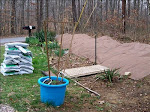
Mulch Madness
After some much-needed KP in the yard we turned our eyes to the Big Daddy of gardening: mulch. Mulch is our friend. In the front yard where the flower and herb beds are located we’ve mulched twice a year. However, the side yard hasn’t had that luxury, so I spread thin layers of wet newspaper on the ground and covered every bed with a thick layer of peat moss. Then I mulched with pine straw.
After some much-needed KP in the yard we turned our eyes to the Big Daddy of gardening: mulch. Mulch is our friend. In the front yard where the flower and herb beds are located we’ve mulched twice a year. However, the side yard hasn’t had that luxury, so I spread thin layers of wet newspaper on the ground and covered every bed with a thick layer of peat moss. Then I mulched with pine straw.
Composting: Compost is one of the essential ingredients of gardening. Here at Golden Acre we compost almost everything. So far so good. When I turned compost pile #2 (the older one), it was steaming. I fenced the area with chicken wire to keep out the neighborhood dogs. That will be garden #2. Then we dumped out the rawer compost #1 (revolting) and covered it with manure and clay and dirt and peat moss and newspapers. I was surprised at how much composting had actually taken place in the garbage can (compost #1). Now we’ve started compost #3, which is going to be a second garden bed in the fall. 

Birds at the Feeder: Besides the birds already reported, we have a gorgeous red-winged blackbird that lands on our feeder. Different populations and subspecies of Red-winged Blackbirds vary markedly in size and proportions. An experiment was conducted that moved nestlings between populations and found that the chicks grew up to resemble their foster parents. This study indicated that much of the difference seen between populations is the result of the different environments.
The Red-winged Blackbird is a highly polygynous species, with one male having up to 15 different females making nests in his territory. In some populations 90% of territorial males have more than one female. But, from one quarter to up to half of the young in "his" nests do not belong to the territorial male. Instead they have been sired by neighboring males.
The male Red-winged Blackbird fiercely defends his territory during the breeding season. He may spend more than a quarter of all the daylight hours in territory defense. He vigorously keeps all other males out of the territory and defends the nests from predators. He will attack much larger animals, including horses and people. The Red-winged Blackbird forms roosting congregations in all months of the year. In the summer it will roost in small numbers at night in the wetlands where it forages and breeds. In winter, it can form huge congregations of several million birds, which congregate in the evening and spread out each morning. Some may travel as far as 80 km (50 mi) between the roosting and feeding sites. It commonly shares its winter roost with other blackbird species and European Starlings. http://www.birds.cornell.edu/AllAboutBirds/BirdGuide/Red-winged_Blackbird.html#conservation
The Red-winged Blackbird is a highly polygynous species, with one male having up to 15 different females making nests in his territory. In some populations 90% of territorial males have more than one female. But, from one quarter to up to half of the young in "his" nests do not belong to the territorial male. Instead they have been sired by neighboring males.
The male Red-winged Blackbird fiercely defends his territory during the breeding season. He may spend more than a quarter of all the daylight hours in territory defense. He vigorously keeps all other males out of the territory and defends the nests from predators. He will attack much larger animals, including horses and people. The Red-winged Blackbird forms roosting congregations in all months of the year. In the summer it will roost in small numbers at night in the wetlands where it forages and breeds. In winter, it can form huge congregations of several million birds, which congregate in the evening and spread out each morning. Some may travel as far as 80 km (50 mi) between the roosting and feeding sites. It commonly shares its winter roost with other blackbird species and European Starlings. http://www.birds.cornell.edu/AllAboutBirds/BirdGuide/Red-winged_Blackbird.html#conservation
Planted: Beans and flower seeds.
Harvested: Our back ½ acre was (once again) covered in the “hay” from cutting. I raked it up and added it to the compost heap. Also harvested basil, Greek oregano, and fennel.
Prepped: To keep the neighborhood dogs out of the compost #2, I fenced it with chicken wire. That’s our prep area for the next two garden beds.
Managed:
Mulched like a crazy woman.
Staked and tied plants. I use panty hose to tie up plants because they stretch and also are full of static.
Turned out the compost from #1 to #2.
Suckered the tomato plants.
The following two sites offer information and diagrams about suckering your tomatoes. Please refer to both sites, since they offer differing opinions. “Knowing the growth habit of the variety you are growing is critical in determining whether a plant can be pruned and the level of pruning.” Plant Doctorhttp://www.nysaes.cornell.edu/pubs/ask/tomato_qa.html
http://www.taunton.com/finegardening/how-to/articles/pruning-tomatoes.aspx
Harvested: Our back ½ acre was (once again) covered in the “hay” from cutting. I raked it up and added it to the compost heap. Also harvested basil, Greek oregano, and fennel.
Prepped: To keep the neighborhood dogs out of the compost #2, I fenced it with chicken wire. That’s our prep area for the next two garden beds.
Managed:
Mulched like a crazy woman.
Staked and tied plants. I use panty hose to tie up plants because they stretch and also are full of static.
Turned out the compost from #1 to #2.
Suckered the tomato plants.
The following two sites offer information and diagrams about suckering your tomatoes. Please refer to both sites, since they offer differing opinions. “Knowing the growth habit of the variety you are growing is critical in determining whether a plant can be pruned and the level of pruning.” Plant Doctorhttp://www.nysaes.cornell.edu/pubs/ask/tomato_qa.html
http://www.taunton.com/finegardening/how-to/articles/pruning-tomatoes.aspx
We bought two 9 ft. canvas umbrellas to provide much-needed shade in the garden.
Weeded
Enlarged one of the garden beds.
Stored: Ordered an extra 90-day supply of medications from Canada (at extremely reduced savings). Stored two more gallons of drinking water, 6 quarts of lamp oil, and some canned tomatoes. Froze two quarts of fresh green beans.
Cooked Something New: Ate something new…fiddle head ferns!
Local Food Systems: I checked with the county website and found a recycling center that is very close to our home. I’ve already taken our recycling over there once. Also I located a nearby local farm that sells organic meats, eggs and produce.
Learned Something New: This time of year we’re infested with June bugs. “The beginning of summer is usually marked by the arrival of two noisy and clumsy beetles. Both are called June Bugs but it is easier to give them different names. The June Bug that's familiar to most is the big green kind that can be seen crashing into the side of the house during its uncontrolled flights on hot summer days. The other June Bug is really the May Beetle. This is the smaller brown beetle that is usually crashing into the lights at night during its uncontrolled flights on hot summer nights. They may look different and are active at opposite times but they have similar life cycles and one of them is actually so good to eat that it can "heal what ails ya." And if laughter is the best medicine then the other is useful too.”
Stored: Ordered an extra 90-day supply of medications from Canada (at extremely reduced savings). Stored two more gallons of drinking water, 6 quarts of lamp oil, and some canned tomatoes. Froze two quarts of fresh green beans.
Cooked Something New: Ate something new…fiddle head ferns!
Local Food Systems: I checked with the county website and found a recycling center that is very close to our home. I’ve already taken our recycling over there once. Also I located a nearby local farm that sells organic meats, eggs and produce.
Learned Something New: This time of year we’re infested with June bugs. “The beginning of summer is usually marked by the arrival of two noisy and clumsy beetles. Both are called June Bugs but it is easier to give them different names. The June Bug that's familiar to most is the big green kind that can be seen crashing into the side of the house during its uncontrolled flights on hot summer days. The other June Bug is really the May Beetle. This is the smaller brown beetle that is usually crashing into the lights at night during its uncontrolled flights on hot summer nights. They may look different and are active at opposite times but they have similar life cycles and one of them is actually so good to eat that it can "heal what ails ya." And if laughter is the best medicine then the other is useful too.”



















 I have one itty bitty green tomato. It may never make it to maturity, but I’m happy to see its little face. This is one of four Early Girl tomatoes I rescued from the burnt up and dead plant section.
I have one itty bitty green tomato. It may never make it to maturity, but I’m happy to see its little face. This is one of four Early Girl tomatoes I rescued from the burnt up and dead plant section. 









